Technical Information
Linear Encoders with Single-Field Scanning
HEIDENHAIN linear encoders are used as position measuring systems on machine tools, in handling and automation technology, and in measuring and inspecting equipment. Sealed linear encoders are protected from dust, chips and splash fluids and are ideal for operation on machines and systems with harsh operating environments in regard to contamination. Because of their compact design, they are also very effective in direct drives and assembly automation. Exposed linear encoders are used on fast, precise machines and systems, such as production and measuring equipment in the semiconductor industry, ultra-precision machines, measuring machines and precision devices in linear metrology, direct drives, etc.
The most important requirements of these applications are:
- High positioning accuracy
- High traversing speed
- High machine availability
- Finely tuned velocity control
With the single-field scanning principle for linear encoders, HEIDENHAIN is fulfi lling these requirements. This method is characterized particularly by signifi cantly reduced sensitivity to contamination, and higher quality of the output signal.
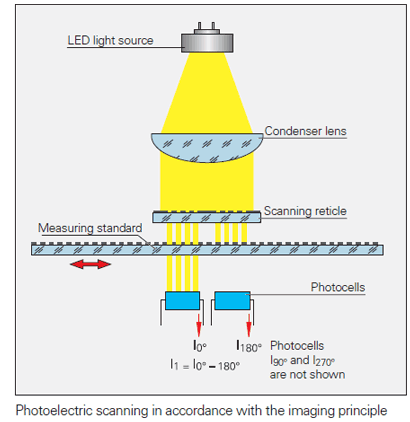 Photoelectric scanning
Photoelectric scanning
Like most HEIDENHAIN encoders, the linear encoders operate according to the principle of photoelectrically scanning a regularly structured measuring standard. In the imaging scanning principle, as it is used for example in the LS sealed linear encoders, a structured scale moves relative to an opposed grating—the index grating—with an identical or similar structure. The incident light is modulated: if the gaps are aligned, light passes through. If the lines of one grating coincide with the gaps of the other, no light passes through. Photovoltaic cells convert these variations in light intensity into electrical signals.
Signal Generation with the Imaging Scanning Principle
The type of scanning is crucial for the quality of the output signals and therefore both for the positioning accuracy and for traversing speed. Optical systems are sensitive by nature to contamination of all types. With the new single-field scanning principle, it has become possible to improve both qualities decisively. This illustration compares it with the previous 4-field scanning.
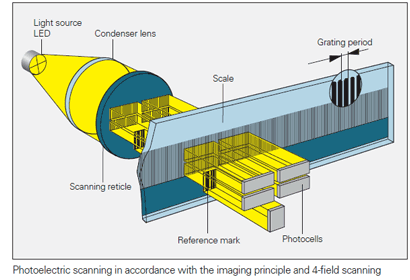 Signal generation with 4-field scanning
Signal generation with 4-field scanning
The scanning reticle has scanning fields
whose gratings are offset to one another
by one fourth of a grating period each. The
corresponding photovoltaic cells generate
sinusoidal signals, phase-shifted to one
another by 90° (elec.). These scanning
signals are not at fi rst symmetrical about
the zero line. For this reason the photovoltaic
cells are connected in a push-pull circuit,
producing two output signals I1 and I2 in
symmetry with respect to the zero line and
electrically phase-shifted by 90°.
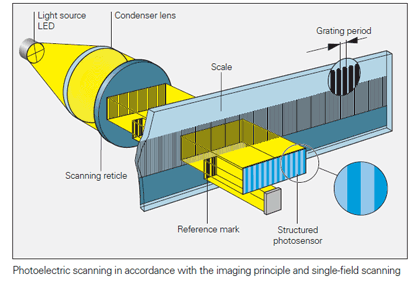 Signal generation with single-field
scanning
Signal generation with single-field
scanning
The scanning reticle has one large-area
grating whose grating period differs slightly
from that of the scale. This generates an
optical beat along the length of the
scanning fi eld: at some positions the lines
coincide and let the light through. At other
locations the lines and gaps coincide,
causing a shadow. In between, the gaps
are only partially covered. This causes a
type of optical filtering that allows
homogeneous signals of a shape very
close to a sine wave. Instead of individual
photovoltaic cells, one large-area, specially
structured photosensor generates the four
90° electrically phase-shifted scanning
signals.
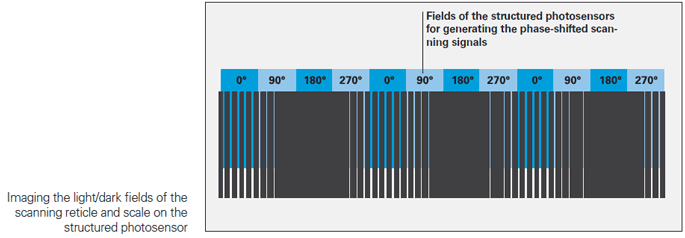
Benefits of Single-Field Scanning
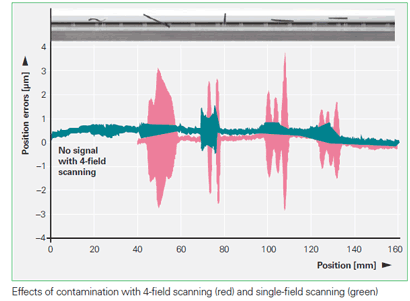
Insensitive to contamination
The large scanning area over the entire
width of the scale grating and the arrangement
of several scanning fields in succession
make the encoders with single-field
scanning extremely insensitive to contamination.
The results of corresponding contamination
tests prove this: even when
contamination over large areas is simulated,
the encoder continues to provide
high-quality signals. The position error
remains far below the value specifi ed for
the accuracy grade of the encoder.
In many cases, depending on the contamination, this can even prevent encoder failure where 4-field scanning cannot.
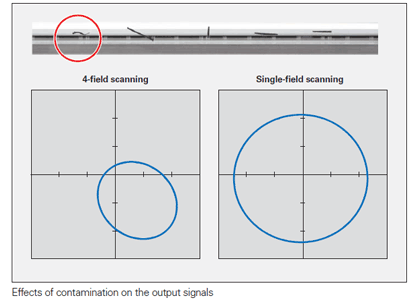
This example shows the influence of contamination on the output signals.
In the XY representation on an oscilloscope the signals form a Lissajous figure. Ideal output signals appear as a concentric inner circle. Deviations in the circular form and position are caused by position error within one signal period (see Measuring Accuracy) and therefore go directly into the result of measurement. The size of the circle, which corresponds with the amplitude of the output signal, can vary within certain limits without influencing the measuring accuracy.
In the encoder with single-field scanning, however, one sees only a small change in the amplitudes. In the XY display, only the diameter changes slightly—a sure sign of very low position error. This type of contamination has very striking effects with 4-field scanning: Because two scanning fields are involved, the XY display shows an extremely eccentric ellipse. This causes a total failure of the encoder at this position.
Better signal quality
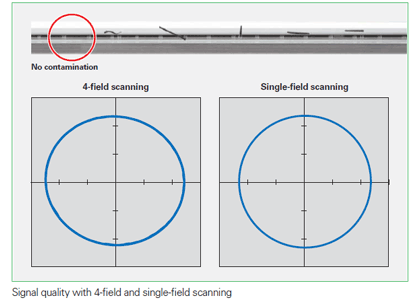 Encoders from HEIDENHAIN acquire their
accuracy fi rst of all from the high quality of
the line grating on the measuring standard.
The sinusoidal output signals are interpolated
in order to achieve application-oriented
measuring steps of 0.1 μm and finer. This
results in additional position errors within
one signal period because of asymmetric
signals and deviations from the sinusoidal
form. These position errors are random and
can therefore not be compensated.
Encoders from HEIDENHAIN acquire their
accuracy fi rst of all from the high quality of
the line grating on the measuring standard.
The sinusoidal output signals are interpolated
in order to achieve application-oriented
measuring steps of 0.1 μm and finer. This
results in additional position errors within
one signal period because of asymmetric
signals and deviations from the sinusoidal
form. These position errors are random and
can therefore not be compensated.
The single-field scanning method has considerable influence here: The large scanning field and the special optical filtering generate scanning signals with high constancy and good sinusoidal form over the entire path of traverse. This substantially reduces position error within the signal period. This is very visible on the XY display of the oscilloscope: The output signals of the linear encoders with single-field scanning show a more circular form and less signal noise.
This is the prerequisite for
- Small position error within one signal period
- Good control quality for direct drives, which means improved, finely tuned velocity control
- High repeatability
Even high, electrically permissible traversing
speeds are made possible by the
high-quality output signals of single-field
scanning. Because the signal amplitudes
are only slightly influenced by velocity, stable
output signals ensure reliable interpolation
even at increased traversing speeds.


 Print
Print